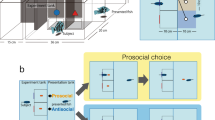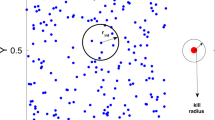Abstract
The problems of achieving mutual cooperation can be formalized in a game called the Prisoner's Dilemma in which selfish defection is always more rewarding than cooperation1. If the two protagonists have a certain minimum probability of meeting again a strategy called TIT FOR TAT is very successful2. In TIT FOR TAT the player cooperates on the first move and thereafter does whatever the opponent did on the previous move. I have studied the behaviour of fish when confronting a potential predator, because conflicts can arise within pairs of fish in these circumstances which I argue resemble a series of games of Prisoner's Dilemma. Using a system of mirrors, single three-spined sticklebacks (Gasterosteus aculeatus) approaching a live predator were provided with either a simulated cooperating companion or a simulated defecting one. In both cases the test fish behaved according to TIT FOR TAT supporting the hypothesis that cooperation can evolve among egoists.
This is a preview of subscription content, access via your institution
Access options
Subscribe to this journal
Receive 51 print issues and online access
$199.00 per year
only $3.90 per issue
Buy this article
- Purchase on Springer Link
- Instant access to full article PDF
Prices may be subject to local taxes which are calculated during checkout
Similar content being viewed by others
References
May, R. M. Nature 292, 291–292 (1981).
Axelrod, R. & Hamilton, W. D. Science 211, 1390–1396 (1981).
Trivers, R. Q. Rev. Biol. 46, 35–57 (1971).
Lombardo, M. P. Science 227, 1363–1365 (1985).
Axelrod, R. Am. pol. Sci. Rev. 75, 306–318 (1981).
Magurran, A. E., Oulton, W. J. & Pitcher, T. J. Z. Tierpsychol. 67, 167–178 (1985).
Magurran, A. E. & Girling, S. L. Anim. Behav. 34, 510–518 (1986).
Magurran, A. E. & Pitcher, T. J. Proc. R. Soc. (in the press).
George, C. J. W. Thesis, Harvard Univ. (1961).
Pitcher, T. J., Green, D. A. & Magurran, A. E. J. Fish Biol. 28, 439–448 (1986).
Pitcher, T. J. in The Behaviour of Teleost Fishes (ed. Pitcher, T. J.) 294–337 (Croom Helm, London, 1986).
Huntingford, F. A. Anim. Behav. 24, 245–260 (1976).
Milinski, M. Behaviour 93, 203–216 (1985).
Bossema, I. & Benus, R. F. Behav. ecol. Sociobiol. 16, 99–104 (1985).
Regelmann, K. & Curio, E. Behaviour 97, 10–36 (1986).
Hamilton, W. D. J. theor. Biol. 31, 295–311 (1971).
Wotton, R. J. The Biology of the Sticklebacks (Academic, London, 1976).
Milinski, M. & Heller, R. Nature 275, 642–644 (1978).
Huntingford, F. A. Anim. Behav. 30, 909–916 (1982).
Magurran, A. E. Behav. ecol. Sociobiol. 19, 267–273 (1986).
Magurran, A. E. in The Behaviour of Teleost Fishes (ed. Pitcher, T. J.) 338–365 (Croom Helm, London, 1986).
Ohguchi, O. Prey Density and Selection against Oddity by Three-spined Sticklebacks (Parey, Berlin, 1981).
Author information
Authors and Affiliations
Rights and permissions
About this article
Cite this article
Milinski, M. TIT FOR TAT in sticklebacks and the evolution of cooperation. Nature 325, 433–435 (1987). https://doi.org/10.1038/325433a0
Received:
Accepted:
Issue Date:
DOI: https://doi.org/10.1038/325433a0
This article is cited by
-
Simulating individual movement in fish
Scientific Reports (2023)
-
Cooperation in alternating interactions with memory constraints
Nature Communications (2022)
-
Inferring strategies from observations in long iterated Prisoner’s dilemma experiments
Scientific Reports (2022)
-
Game Theory and the Evolution of Cooperation
Journal of the Operations Research Society of China (2022)
-
Better models of the evolution of cooperation through situated cognition
Biology & Philosophy (2021)
Comments
By submitting a comment you agree to abide by our Terms and Community Guidelines. If you find something abusive or that does not comply with our terms or guidelines please flag it as inappropriate.



